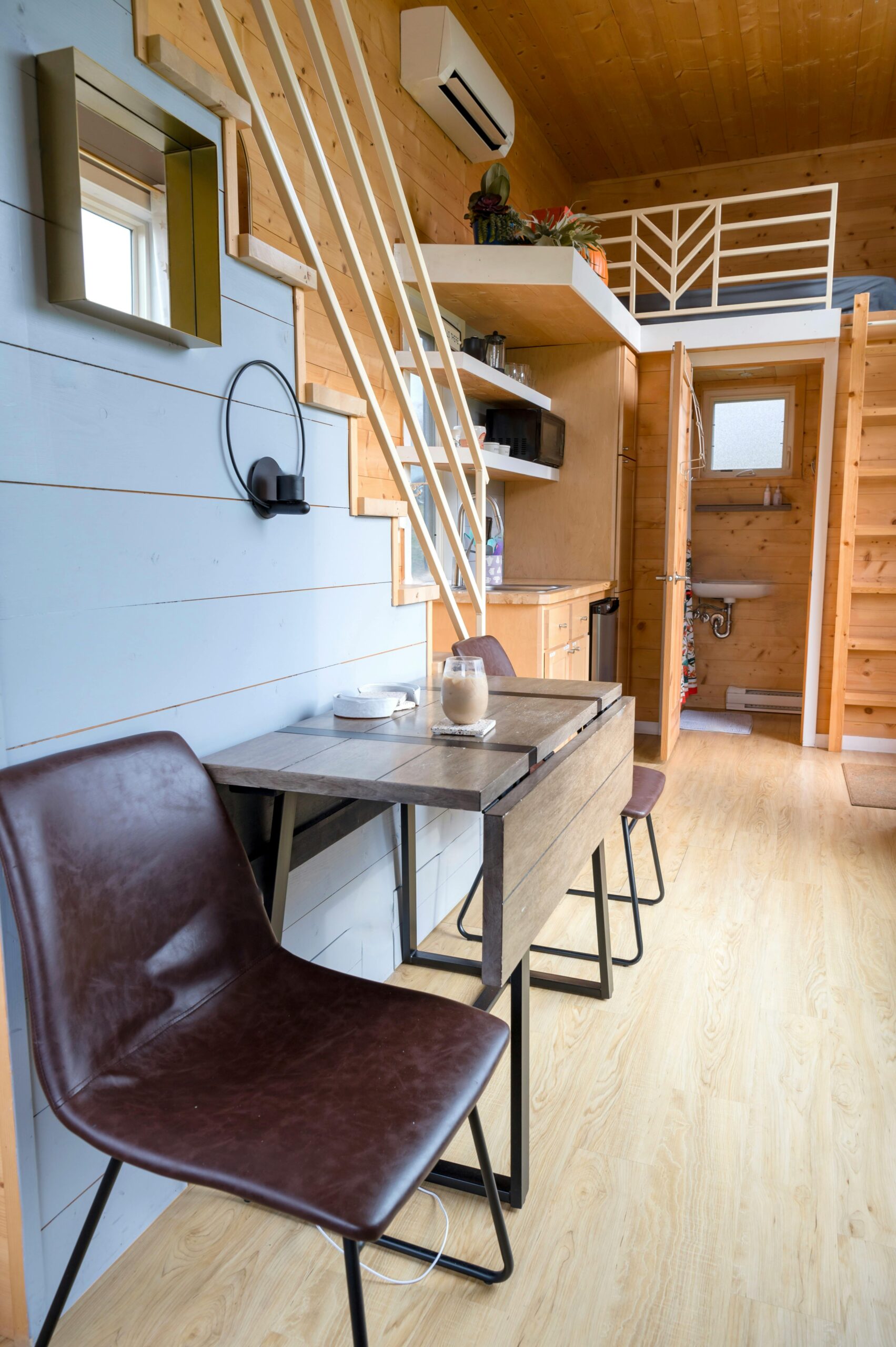
At 62, most would settle into a quieter life, but one former Wall Street exec had other plans. Leaving behind a high-powered career, he set out to tackle a crisis few dare to confront—homelessness. His solution? Tiny homes for homelessness. Building tiny homes that offer big hope. In this inspiring story, you’ll meet a man proving it’s never too late to start changing lives.
From Wall Street to Advocacy: A Bold Transition

What drives someone to transition from corporate skyscrapers to a mission of human connection? For one former Wall Street executive, the answer lies in combining strategic prowess with heartfelt purpose.
Overview of Wall Street Career
Spending over 30 years on Wall Street, this individual built a reputation for success in investment banking and financial strategy. Navigating complex markets, they managed portfolios worth millions and guided clients through volatile economies. Recognition from peers and inclusion in industry accolades highlighted their sharp insight and influence.
Wall Street’s high-stakes environment required excellence in time-sensitive decision-making, a skill honed over countless deals. Yet behind the numbers and triumphs lay a growing longing for greater life impact. Learn more about the competitive Wall Street careers.
Prompt for Career Shift

What sparks a career reboot after decades of success? A few key moments stood out. Volunteering at local shelters revealed a hidden crisis—systemic homelessness. Each story told by individuals experiencing homelessness chipped away at the allure of corporate wins. Another tipping point came during a keynote speech they attended. The speaker boldly asked, “How are you using your privilege to inspire change?” It ignited an internal debate that led them to reevaluate their path.
Why tiny homes? Conversations with nonprofit leaders pointed to these sustainable dwellings as an immediate way to address housing shortages. Building them fueled their drive to pair financial knowledge with grassroots activism. Insights from others who’ve pivoted from finance to advocacy show that this transition is deeply fulfilling, though rare.
Skills Applied to the Mission
A Wall Street career imparts skills that thrive far beyond trading floors. Financial planning became pivotal in budgeting for nonprofit projects and fundraising initiatives. Project management expertise allowed seamless coordination between architects, volunteers, and community leaders. Risk assessment, once used to predict market downturns, now shields projects from costly setbacks.
Key transferable skills include:
- Negotiation: Securing land and materials often involved intense discussions akin to closing financial deals.
- Strategic vision: Mapping out five-year growth plans for the initiative mirrored corporate roadmaps.
- Leadership: Years of managing teams helped rally volunteers with clarity and purpose.
Valuable resources like this guide on project financial management explain the core principles behind harnessing such skills effectively.
The Idea Behind Tiny Homes for People Experiencing Homelessness
Tiny homes have emerged as a practical response to the homelessness crisis, providing individuals with safe and affordable shelter. This approach emphasizes solutions that are not just temporary but meaningful, sustainable, and cost-effective. Below, we explore what makes these homes unique, why they’re gaining traction and the challenges of developing them.
What are Tiny Homes?
Tiny homes are small-scale housing units designed to serve big purposes. Typically ranging from 100 to 400 square feet, these compact dwellings are built to maximize space functionality. Their construction uses cost-effective materials like repurposed wood, metal, or shipping containers.
Key characteristics of tiny homes include:
- Affordable pricing: On average, tiny homes cost between $10,000 and $50,000 to build.
- Simplified design: Minimalist layouts ensure efficient use of space.
- Mobility options: Some are stationary, while others are mounted on wheels for portability.
They may be small, but tiny homes are built with intention. They offer privacy, safety, and comfort to individuals who previously lacked these essentials.
Focus on Tiny Homes

Why tiny homes? They’re not just a quick fix; they offer long-term benefits for communities and residents alike. One of their strongest appeals is cost-effectiveness. Traditional shelters and permanent housing projects can take years and millions of dollars to complete, while tiny homes can be finished in weeks or months with significantly smaller budgets.
Additionally, tiny homes emphasize sustainability using renewable energy sources like solar panels and eco-friendly materials. They also leave a smaller environmental footprint than traditional housing. According to studies, many tiny homes are designed to operate off-grid, reducing reliance on public utilities. Read more about the benefits of tiny homes for addressing homelessness.
Moreover, tiny homes offer:
- Dignity and autonomy: Residents have their own space, unlike shared shelters.
- Speedy solutions: Units can be scaled up quickly to meet urgent needs.
Governments and nonprofits are finding that tiny homes allow them to blend innovative design with tangible outcomes. Learn how tiny homes are transforming lives in California.
Challenges of Tiny Home Projects

The path to establishing tiny home communities isn’t without roadblocks. One major hurdle is navigating zoning laws. Many municipalities lack clear regulations for these smaller units, leaving developers tangled in red tape. For example, some states classify tiny homes as recreational vehicles, limiting their use as permanent housing. Explore more about zoning constraints here.
Another challenge is fundraising. While tiny homes are more affordable than traditional housing, upfront costs still require substantial community or organizational funding. Securing grants, sponsorships, or private investment often demands enormous effort. Organizations must balance financial accountability with a compelling case to win over donors. Foundations like Oak Foundation are helping to fund tiny home villages.
Finally, there’s the issue of community resistance. Despite their benefits, some neighborhoods oppose tiny homes due to misconceptions or “Not In My Backyard” (NIMBY) attitudes. Overcoming stigma and educating the public remain key elements for the widespread adoption of these solutions.
Tiny homes may not solve the homelessness crisis alone but represent a creative and strategic step forward. By addressing both individual needs and more significant systemic issues, they offer hope for a better tomorrow.
Building the Mission

Because turning a bold idea into reality takes planning, resources, and collaboration. This tiny home project had a compelling mission: tackle homelessness head-on with innovative, cost-effective solutions. Here’s how it went from just an idea to a life-changing initiative.
Key Steps Taken: Idea Development, Funding, and Partnerships
The journey started with a spark of inspiration—a desire to address the housing crisis in a tangible, sustainable way. The former Wall Street executive knew they had the expertise to make a difference, but it required a concrete plan.
- Developing the Concept: The first step was research. They explored the tiny home movement’s practical benefits and sought advice from nonprofits and housing experts. The goal was clear: create affordable, efficient, and scalable housing for those in need. Learn how organizations structure tiny home projects.
- Securing Funding: Financing was critical. A mix of personal savings, crowdfunding, and partnerships allowed the initiative to move forward. Grants from organizations like the Oak Foundation and Sobrato Philanthropies played a massive role. These financial backers understood the impact tiny homes could have in reducing homelessness. Examples of funding efforts for such projects can be found here.
- Building Partnerships: It wasn’t a solo endeavor. Partnerships with local governments, architects, and nonprofits were key. Operation Tiny Home and other groups lent expertise in design and logistics. By bringing community leaders to the table, the project gained momentum and credibility. Learn more about partnerships here.
As a result, this groundwork ensured the concept transformed from paper plans into a practical housing solution.
Stories of Collaboration: Contributions to the Project’s Success
Collaboration was the backbone of this mission. No one can solve homelessness alone, and this project was no exception. Hundreds of individuals contributed their time, skills, and resources.
- Local Volunteers: Hosting build events brought together people passionate about making a difference. From framing walls to painting, every set of hands made progress possible.
- Nonprofits and Universities: Groups like the Low Income Housing Institute and university architecture programs contributed designs and labor. For instance, the University of South Florida helped construct homes for veterans. Learn more about their stories here.
- Community Sponsors: Businesses donated materials, and foundations offered grants. This financial and in-kind support helped stretch resources further.
These partnerships lightened the workload and fostered a sense of shared purpose.
Timeline of Progress: From Concept to Execution
The project’s timeline reflects determination and agility, carefully balancing speed with quality construction.
- Year One – Research and Planning: Initial research defined the scope and feasibility. By year’s end, funding and blueprints were in place.
- Year Two – Breaking Ground: The first two tiny homes were constructed as prototypes. Adjustments were made based on lessons learned.
- Year Three – Scaling Up: A small community of 15 homes was completed with support from nonprofits and local governments.
So, the progress might seem gradual, but every milestone represented a step closer to giving individuals a chance at stability and independence. Learn about similar timelines for housing projects.
This journey proves that change, though not instantaneous, is worth the wait when lives are transformed.
Impact of the Initiative

The initiative to build tiny homes for people experiencing homelessness has an undeniable ripple effect. It’s transforming lives, creating hope, and inspiring broader change. Here’s how.
Tangible Results: Provide statistics on homes built and people helped.
This mission isn’t just about ideas; it’s about results. Since its inception, the initiative has constructed over 150 tiny homes across various communities. These homes have offered shelter to more than 180 individuals, including veterans, families, and young adults experiencing homelessness.
Data revealed groundbreaking outcomes in pilot programs, such as the one in California. Nearly 70% of residents transitioned to more stable housing within a year. This success is reflected in national efforts, with tiny homes proving effective at moving people from temporary shelters to permanent solutions.
The financial impact is just as striking. Building a tiny home costs an average of $20,000 to $50,000, far less than traditional housing projects. This affordability allows the program to stretch resources to help more people faster.
Human Stories: Include quotes or experiences from beneficiaries.
Behind these numbers are real people finding hope and stability. For Sarah, a young mother, moving into a tiny home marked the end of years spent in shelters. “My son now has a place to call home, and I can finally focus on building our future,” she said.
Veterans like John echo similar sentiments. After years of living on the streets, he shared, “This tiny home gave me back my dignity. I feel like me again.”
These homes don’t just provide a roof over someone’s head; they rebuild self-worth. Residents often describe their new living conditions as a foundation for pursuing work, education, and personal fulfillment. Each home becomes a symbol of a second chance.
Broad Societal Impact: Discuss how the initiative raises awareness about homelessness.
The initiative is more than housing; it’s sparking essential conversations about homelessness. By addressing the stigma head-on, it’s challenging the “Not In My Backyard” (NIMBY) mindset that often stalls progress. Articles such as this one highlight how small steps like these create waves of reform that can influence housing policies nationwide.
Tiny homes are also inspiring new partnerships across industries. Community members, nonprofits, and local governments are investing not just in the homes themselves but in complementary services like mental health support and job placement assistance. These efforts underline an important truth: sustainable housing solutions are about more than structures; they’re about people.
This project is encouraging cities across the U.S. to adopt similar initiatives by showcasing effective models. It’s a movement proving that when you pair creativity with compassion, you can build something much bigger than a home; you build hope.
Lessons Learned from the Transition
This story of transformation highlights more than a career change; it’s about redefining purpose and tackling societal challenges. Moving from a Wall Street career to spearheading a tiny homes initiative offers powerful insights that resonate personally and broadly. Here are the standout lessons.
Personal Takeaways: Summarize lessons in fulfillment and purpose
Transitioning from Wall Street to a mission-driven life reshaped what success means. The individual behind this story learned that true fulfillment doesn’t come from accolades or financial milestones. Instead, it stems from making tangible differences in people’s lives. Building tiny homes gave him a sense of accomplishment no corner office could ever replicate.
Key takeaways include:
- Priorities evolve: Achievements once anchored in financial benchmarks shifted to human connection and social impact.
- Impact trumps income: Wall Street’s monetary rewards fade compared to the emotional value of helping others.
- Continued growth: Even at 62, taking on new challenges proved personal growth never stops.
These lessons remind us that while career transformations may look daunting, they often unlock a more profound sense of purpose and identity. Explore more personal lessons from career transitions.
Broader Lessons for Readers: Encourage finding meaning and making a difference
What message does this story send to others? It’s a beacon of possibility, proving you don’t need to stick to the status quo. This tale encourages readers to reflect on their impact on the world.
Questions to consider:
- What small change could you make to help others?
- Are you using your skills to create a legacy beyond personal gain?
Making a shift doesn’t have to be monumental. Take stock of your strengths and interests and align them with causes that matter to you. Doing meaningful work could start with volunteering, mentoring, or supporting local initiatives.
The broader takeaway? It’s never too late to pursue purpose over profit. Start small and build from there. Discover insights from others who made impactful life changes here.
Challenges Overcome: Describe significant obstacles and solutions
This journey wasn’t without struggles. From navigating complex zoning laws to rallying financial support, the challenges tested patience and ingenuity.
The most significant hurdles included:
- Securing funding: Crowdfunding, grants, and partnerships helped overcome this. Organizations like Operation Tiny Home offered guidance.
- Zoning restrictions: Crafting proposals with local governments required innovative problem-solving and persistence.
- Building credibility: Convincing stakeholders to trust a “Wall Streeter” turned advocate wasn’t instant. Consistent actions spoke louder than words.
The solutions weren’t always straightforward, but each obstacle became an opportunity to build resilience. Despite setbacks, the project’s success proves that persistence and creativity can overcome even the most formidable barriers. Learn about overcoming challenges in nonprofit work.
How Others Can Get Involved
The success of any initiative depends on collective action and community support. If you’ve been inspired by the story of a 62-year-old Wall Street executive building tiny homes to combat homelessness, you may wonder how to contribute. Here are actionable ways to get involved and make a difference.
Ways to Support: Donations and Volunteering
Supporting housing initiatives can be as simple as showing up or offering resources. Whether you’re strapped for time or looking to make a long-term commitment, there are plenty of ways you can contribute.
No matter how small, every action moves the needle toward meaningful change.
Resources to Learn More: Tiny Homes and Housing

Want to deepen your understanding of solutions like tiny homes? Excellent resources are available to guide your journey.
These tools help you learn and connect you with like-minded advocates and organizations.
Encouragement for Action: Steps Toward Change
Feeling inspired? Now’s the time to act. Remember, you don’t need a Wall Street background or a lifetime of expertise to make a difference.
- Start Small: Even a few hours of volunteering can have a significant impact.
- Team Up: Collaborate with friends or local organizations to amplify your efforts.
- Speak Up: Share stories, advocate for policy changes, or write to local government officials.
Ask yourself: What skills or resources do I have that could make a difference? Then, take that first step. As the saying goes, “A single brick can build a home.”
Frequently Asked Questions About the Initiative
Every great endeavor raises questions. From leaving a career on Wall Street to funding tiny homes for people experiencing homelessness, the path is inspiring yet intricate. Below, we address some common questions to provide clear insights into this project.
The decision to Leave Wall Street: How did this 62-year-old make the leap from finance to philanthropy?
Leaving Wall Street wasn’t an impulsive move. It started with deep reflection and a purpose-driven direction. After years of sitting in boardrooms, this individual began volunteering at homeless shelters during weekends. Each interaction revealed pressing concerns that couldn’t be ignored.
A series of events solidified the decision. A keynote speaker asked, “How are you using your privilege to make change?” It lingered. The decision became clear when combined with the dissatisfaction with simply growing bank accounts rather than human lives. Sacrificing a lucrative career seemed small compared to the opportunity to affect real lives. Read more about how people make purpose-driven decisions after highly demanding careers.
Benefits of Tiny Homes: Why are they effective for homeless populations?
Tiny homes provide immediate, tangible benefits for homelessness that traditional solutions lack.
- Affordability: A single tiny home costs far less than average housing expenses.
- Privacy and Personalization: Unlike communal shelters, these homes create personal safe spaces that foster dignity.
- Eco-Conscious Living: Tiny homes often incorporate renewable resources like solar energy, offering environmental and operational efficiencies.
- Quick Deployment: Entire communities can be assembled in weeks, making them ideal for urgent housing needs.
Many residents credit these homes with transforming their lives. They say their sense of security helps them rebuild their confidence and start focusing on career opportunities. Explore deeper insights on why tiny homes matter in tackling homelessness here.
Funding and Building Tiny Homes: How are these projects financed and constructed?
The financial blueprint behind tiny homes blends creativity with strategy.
- Funding Sources: Backers include crowdfunding campaigns, private company donations, and specific grants like those from nonprofit giants. Some state governments even offer financial incentives for tiny home projects. For instance, California provides up to $40,000 per project.
- Construction Process: Skilled and unskilled volunteers join forces for construction, with designs emphasizing low-cost but sturdy materials. Partnerships with organizations like Operation Tiny Home simplify the logistics of sourcing materials and navigating permits.
Want to fund similar projects? Resources like this guide on tiny home financing can help you get started.
Challenges in Transitioning: What are the biggest obstacles to pivoting into advocacy and housing development?
The process isn’t without its hurdles.
- Zoning Laws: Many cities don’t account for tiny homes in their regulations, categorizing them as recreational vehicles rather than permanent housing.
- Community Resistance: “Not In My Backyard” attitudes often lead to push back from neighborhood residents afraid of declining property values.
- Logistical Hurdles: The shift from managing investments in billions to coordinating volunteers and construction sites required a complete mindset change.
Yet, challenges fueled the mission further. For instance, zoning battles sparked dialogue with city officials and led to revised laws favoring tiny home approval. Learn more about overcoming tiny house barriers here.
Starting Initiatives: How can readers begin their own tiny home projects?
Starting a tiny home initiative begins with proper planning.
Here’s what works:
- Research First: Understand local laws and identify communities that would benefit the most from such initiatives.
- Build Partnerships: Align with nonprofits or universities for funding and construction expertise. Organizations like Operation Tiny Home specialize in streamlining these projects.
- Start Small: Demonstrating success with one or two homes can gain community trust and secure broader backing.
Remember, the goal is long-term sustainability, not just short-term fixes. Planning carefully is key.
Similar Projects Worldwide: Are there other initiatives like this?
Yes, the tiny home movement has taken off globally.
- Spur, Texas, USA: Known as the world’s first “tiny home-friendly” town.
- Chiba Prefecture, Japan: Sustainable tiny homes promoting eco-tourism.
- British Columbia, Canada: Local nonprofits constructing affordable homes for new immigrants and homeless veterans.
These examples demonstrate the flexibility of tiny homes to adapt to various needs and geographies. Explore more inspiring global projects here.
Role of Local Governments: What part do authorities play?
Support from local governments is critical. Their influence ranges from policy tweaks to direct investment.
Key actions by local authorities:
- Legislation Changes: Cities like Los Angeles and Kansas City altered zoning laws to make tiny home projects easier.
- Funding and Resources: Governments often provide grants and access to unutilized land.
- Partnerships: They work with nonprofits to maintain tiny home communities while ensuring access to mental health, medical, and employment services.
These policies signal a radical shift in housing to prioritize inclusivity. Governments clearing paths for innovative housing solutions pave the way for nationwide progress. Learn more about government roles in tiny homes.
This FAQ section clarifies the initiative’s motives, methods, and broad-reaching impact while inspiring similar actions worldwide.
Conclusion

The story of a 62-year-old Wall Street executive who left finance to combat homelessness with tiny homes is proof that meaningful change is always within reach. His journey combines purpose, skill, and determination to address a critical societal issue while inspiring others to think bigger.
It’s a call to action for everyone. Whether you donate, volunteer, or share this story, every effort sparks change. Build something that matters, not just for yourself but for those who need it most. Together, we can turn small solutions into life-changing impacts.








Add comment